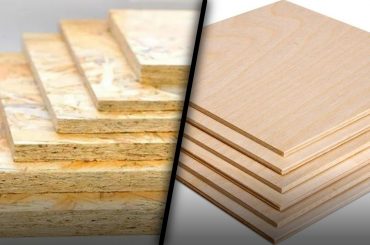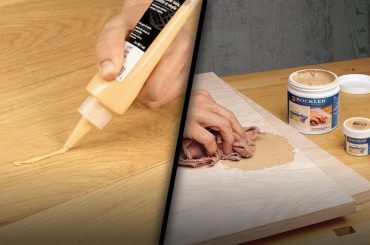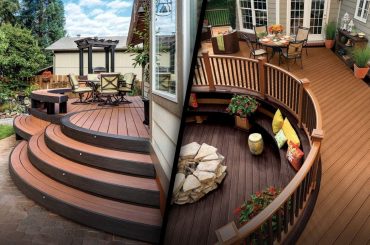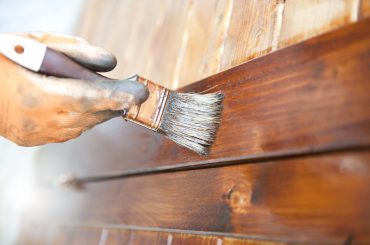It’s often difficult to decide between vinyl and laminate flooring if you’re looking for durable, economical, or attractive flooring that’s easy to install yourself. Each is equally easy to install, costs about the same, and is equally attractive. It appears that the only difference is the name to the untrained eye.
Is there any difference between the two? Yes, of course. In spite of the similarities between vinyl and laminate, there are several crucial differences, such as moisture resistance, durability, and maintenance, that will greatly influence your choice. Here are the pros and cons of laminate and vinyl flooring so you can decide which is right for you.
Vinyl vs. Laminate Flooring: Major Differences
Vinyl and laminate flooring differ primarily in their materials. Several layers of laminate flooring are laminated together, including a wood fiberboard core. Despite its many layers, vinyl flooring can only be made from synthetic materials.
Common types of vinyl flooring include the following:
-
LVP (Luxury Vinyl Planks)
-
LVTs (luxury vinyl tiles)
-
Vinyl sheets
Vinyl flooring is 100 percent synthetic. Vinyl tiles and sheet vinyl usually have a fiberglass base coated with PVC and a plasticizer. A surface print layer is applied to the resulting sheet. A layer of no-wax polyurethane is applied over the wear layers.
A growing number of vinyl floors come with built-in underlayment, though not all. PVC is the core layer of vinyl plank flooring. A floating floor is created by interlocking luxury vinyl planks or tiles. Sheet vinyl flooring typically measures 1.5 mm thick; luxury vinyl planks measure 5 mm thick.
What Is a Floating Floor?
A floating floor is made up of components that lock together without nails, glue, or other fasteners. In contrast to a floating floor, which is physically attached to the subfloor, a floating floor rests on top of it.
Laminate Flooring
LVP’s look and installation method are similar to laminate flooring, which only comes in planks. Wood byproducts are bonded with resins in its core, making it unique. The printed design layer is covered by a hard, transparent plastic wear layer. A laminate floor plank typically has a thickness between 6 and 12 millimeters.
It is possible to install an underlayment built into plank vinyl as well. DIYers are increasingly choosing built-in underlayment over separate underlayments as they want to eliminate the hassle of rolling them out separately.
Appearance
The best flooring option for appearance is laminate. The appearance of laminate flooring and vinyl flooring is generally comparable, but more laminate options mimic hand-scraped hardwood, stone, ceramic, and other materials.
Laminate Flooring
Since laminate flooring has a thick top layer, it’s possible to emboss its surfaces in three dimensions, delivering accurate representations of its natural materials.
Vinyl Flooring
In terms of realistic looks, vinyl floors do not stand out from the rest, but LVP has the highest level of realism. As vinyl flooring becomes thicker and embossed, it will resemble wood more closely.
Cost
The prices of vinyl and laminate flooring are competitive. Sheet vinyl, on the other hand, is often easier on the wallet. Laminates and vinyl floors are often less expensive than hardwoods, engineered woods, and most ceramic and porcelain tiles, making them popular alternatives for those on a budget.
Laminate Flooring
Depending on how thick the planks are, laminate flooring can cost anywhere from $1.00 per square foot for 7mm-thick planks to $5.00 per square foot for 12mm-thick planks.
Vinyl Flooring
It is possible to find thin, glue-down vinyl flooring for as little as $1.00 per square foot. The cost of vinyl for LVP rises to around $5.00 per square foot, and premium brands will be even more expensive. The cost of sheet vinyl is as low as $0.65 per square foot for those looking to save as much money as possible.
Water Resistance
The water resistance of vinyl flooring is greater than that of laminate flooring. Due to the waterproof materials used in sheet vinyl, LVT, and LVP, all types of vinyl flooring are considered waterproof. If there is enough liquid present, seams between planks and tiles can allow water to reach the subflooring. Vinyl flooring materials are preferred over laminate flooring materials in bathrooms and damp locations, such as basements.
Laminate Flooring
Fiberboard is the core of virtually all laminate flooring. As a wood product, this core will soften and swell if exposed to water. After drying, the fiberboard core won’t regain its original dimensions. Occasionally, the wear and design layers peel away after the core becomes waterlogged. A laminate floor that has been severely damaged by water usually needs to be replaced; it cannot be repaired.
Laminate flooring can tolerate pooled water for a short period of time if it is installed properly with tight seams and good baseboards or moldings. Traditional laminate flooring is not recommended for family bathrooms or other areas where standing water is likely. Water-resistant laminate materials may be available in newer versions.
Tip
It is possible to use laminate flooring in areas of low, intermittent moisture if you are willing to clean up spills and puddles promptly.

Vinyl Flooring
Vinyl flooring is waterproof today. The older vinyl flooring may have had a fabric or felt backing that wasn’t waterproof, but newer vinyl flooring is 100% synthetic. In addition to being completely unaffected by water, luxury vinyl flooring can be fully immersed in it for long periods of time, dried out, and reused.
WARNING
Flooring materials that are waterproof do not necessarily protect structural elements below. To prevent damage to the subfloor, water should be removed as soon as possible. For smaller rooms, sheet vinyl in 12-foot wide rolls often requires no seams, making it a great choice for a truly waterproof floor that also protects the subfloor.
Heat Resistance
It is not particularly heat resistant to install vinyl flooring or laminate flooring. Despite the difference in shrinkage and expansion characteristics between vinyl and laminate, both materials share a degree of heat resistance since they can both be damaged under similar conditions. Under laminate flooring, radiant heat may be more effective than under radiant heat floors (provided the temperature is kept at around 80 degrees Fahrenheit).
Laminate Flooring
Dropping something extremely hot onto laminate flooring could cause it to burn. Furthermore, laminate tends to expand and contract when the temperature is constantly changing in a room.
Vinyl Flooring
If something extremely hot is dropped on vinyl flooring, it can easily scorch. Vinyl flooring, however, is not affected by normal temperature fluctuations. An excessive amount of ambient heat can cause problems such as expansion and adhesive melting.
Care and Cleaning
It is easiest to thoroughly clean vinyl flooring. In spite of the ease of maintenance of laminate flooring and vinyl flooring, both allow the full range of cleaning methods to be used, from dry sweeping to wet mopping.
Laminate Flooring
Dry mopping or brooming is the best way to clean laminate flooring first. It is best to use a damp mop that feels almost dry when wet-cleaning laminate flooring.
Vinyl Flooring
Cleaning and caring for vinyl flooring are its strongest features. If necessary, use safe cleaning products to vigorously scrub vinyl flooring in good condition.
Durability and Maintenance
The durability of vinyl flooring is greater than that of laminate flooring. Resilient flooring is an industry term used to describe vinyl floors that are highly durable and low-maintenance. The durability and ease of maintenance of vinyl flooring even make it a popular choice for commercial applications.
Tip
Pets will love vinyl flooring if you choose it as your flooring option. The “click-click” of large pet toenails can also cause laminate to become very loud.
Laminate Flooring
Low maintenance and durable, laminate flooring is an excellent choice. When laminate flooring is exposed to water for too long, its many layers may eventually delaminate. It is not possible to repair laminate once the top wear layer has been scratched or chipped. Water enters the lower layers of the structure once delamination begins to occur.
Vinyl Flooring
With vinyl flooring, you will be able to withstand high traffic demands. In comparison to thick vinyl flooring, thin vinyl flooring is less likely to delaminate over time. Polyvinyl chloride (PVC) is a single cohesive layer, which eliminates delamination problems. There is a possibility of delamination with thicker, more expensive plank vinyl flooring due to its soft underlayment.
Installation
Vinyl flooring is easier to install than laminate flooring. When it comes to ease of installation, both materials have advantages and disadvantages. It is easier to DIY install vinyl or laminate planks than sheet vinyl. The tools needed to work with vinyl are fewer than those needed to work with laminate. It takes a certain level of skill and a saw to install laminate flooring correctly, reducing waste.
Laminate Flooring
In laminate flooring, tongues are fitted into grooves of adjacent planks at an angle to create a click-and-lock installation method. First, the first plank is folded down until it is level with the other plank. As a result of this action, the seam between the boards is closed. Laminated planks are cut with a circular saw or table saw equipped with a fine-tooth blade, or even with a hand saw.
Vinyl Flooring
Click-and-lock installation is also used with vinyl planks. Vinyl flooring planks, however, can be cut easily with a utility knife. The plank is first scored, then bent back on itself and a second cut is made from the rear.
There is one disadvantage of sheet vinyl flooring: it can be difficult to install for DIYers. There are several issues with the material, including its size, weight, and unwieldiness. Furthermore, sheet goods are not easy to cut out intricate shapes. It is often best to hire a professional to install sheet vinyl.
Lifespan
As long as laminate and vinyl flooring are properly cared for, they have similar lifespans. The lifespan of laminate flooring may be similar to that of vinyl flooring if it is kept reasonably dry and regularly cleaned.
Laminate Flooring
The warranty period for laminate flooring typically ranges from 10 to 25 years, but this is dependent on how well it is maintained.
Vinyl Flooring
Luxury vinyl flooring often comes with a 20-year warranty.
Comfort & Sound
It is possible to walk on vinyl and laminate flooring that is both quiet and comfortable. In comparison with the wood floors they are supposed to mimic, laminate flooring products can feel and sound hollow underfoot. However, laminate flooring may be quieter, softer, and more comfortable when combined with foam or felt underlayment.
Laminate Flooring
When coupled with premium-quality underlayment, laminate flooring does have a warm, cozy feel, even though it doesn’t feel like wood. If you wear heels, you may hear people walking on laminate.
Vinyl Flooring
If vinyl floors are installed over concrete or ceramic tile floors, they can feel cold or hard to the feet. Vinyl flooring is typically quiet when you walk with heels on it.
Resale Value
A home’s value can be enhanced by quality laminate flooring and vinyl flooring. It does not bring the high-value prestige of solid hardwood, engineered hardwood, ceramic tile, or natural stone floors. However, prospective buyers are not often put off by quality laminate or vinyl flooring.
Laminate Flooring
When laminate flooring is relatively new and in good condition, it can add resale value to a house.
Vinyl Flooring
A home with luxury vinyl plank flooring from a major brand will have decent resale value. When the house sells, however, cheap vinyl flooring will often be seen as something that needs to be repaired.
Environmental Impact
There is no significant environmental benefit to laminate or vinyl flooring. The natural wood content of the fiberboard core of laminate flooring gives it a small advantage if you are concerned about using green building materials. However, neither of these materials is particularly eco-friendly in the same way that natural wood, linoleum, or bamboo floor coverings are.
Laminate Flooring
LEED MR4 (Recycled Content) qualified laminate flooring products are available from some laminate flooring manufacturers. The laminate flooring has a plastic surface layer, and the melamine resins used to create the core layer could emit chemicals during the manufacturing process.
Vinyl Flooring
Recent years have seen vinyl flooring gain in green status. LEED EQ4.3 Low-Emitting Material credit is now available from some vinyl flooring manufacturers. In the case of vinyl, toxic chemicals are produced when it is burned. It is usually not possible to recycle vinyl, as it does not decompose in landfills.
Stain Resistance
Both laminate and vinyl flooring are stain-resistant. The wear layers of laminate and vinyl flooring are treated with properties that make them stain-resistant.
Laminate Flooring
A clear aluminum oxide layer covers the top layer of laminate flooring, making it stain resistant.
Vinyl Flooring
Stain resistance is excellent with vinyl flooring coated with urethane.
Recommended Installation Areas
It is recommended to use vinyl flooring throughout the home, while laminate flooring should only be used in certain areas. Is vinyl flooring a better choice for your home than laminate flooring?
Installation Areas: What Is Better?
In areas that are prone to water and moisture exposure, vinyl flooring outperforms laminate flooring in terms of water resistance.
Which Is Better?: Laminate or Vinyl Flooring
Laminate flooring does not have any advantages or disadvantages over vinyl flooring. Wet bathrooms, laundry rooms, and mudrooms are the best places to use vinyl flooring. You should choose vinyl flooring simply based on its moisture resistance if you plan to install flooring in those rooms. Laminate flooring is a good choice for dry areas, and it looks better in general. In general, laminate flooring offers more style options to buyers than vinyl flooring.
Top Brands
Laminate Flooring
-
Dream Home (Lumber Liquidators / LL Flooring)
-
Pergo
-
QuickStep
Vinyl Flooring
-
Armstrong
-
Mannington
-
Shaw
FAQ
-
Laminate Flooring Versus Vinyl Flooring: What’s The Difference?
Vinyl flooring and laminate flooring differ primarily in their materials. In contrast to vinyl, laminate contains a fiberboard core constructed from wood byproducts. In contrast, vinyl flooring is 100% waterproof, while laminate flooring is not. Both flooring types are stain-resistant and can be installed with underlayment, but they are constructed differently.
-
Which Is Cheaper, Laminate or Vinyl?
It is often possible to find sheet vinyl flooring for a slightly lower price than laminate flooring. Laminate can be much cheaper than luxury vinyl options.
-
Vinyl or Laminate Lasts Longer?
When properly maintained, laminate flooring and vinyl flooring have similar lifespans, though vinyl flooring is considered more resilient, which may ensure a longer lifespan for many users.
-
Vinyl or Laminate Flooring Is Better For Pets?
When it comes to pet-friendly flooring, vinyl is better than laminate. Vinyl is waterproof because of its 100% synthetic construction.
-
Do Laminates or Vinyls Have a Better Scratch Resistance?
LVT and LVP may tear more easily than vinyl flooring, but vinyl flooring is more scratch-resistant than laminate flooring.





